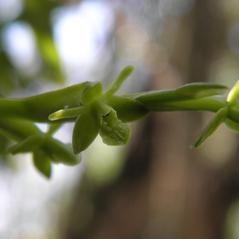Epidendrum rigidum Jacq.
Rigid Epidendrum
Facts About
Accepted Synonyms: Epidendrum cardiophorum, Epidendrum pium, Spathiger rigidus
Epidendrum rigidum, the Rigid Epidendrum, is native to south Florida and the Caribbean Islands, and extends from Mexico to Peru. The erect or pendulous reed-like stems unite at the base to form a creeping rhizome. The leaves are alternate and the inflorescence has large floral bracts with 3-15 sessile, non-resupinate, marcescent flowers on a terminal spike. The alternating pattern of green flowers has given rise to the local name the "zigzag orchid". This orchid grows on tree branches and trunks in swamps and hammocks, including mangrove forests.
Epidendrum rigidum is apparently secure across its wide range but is endangered in south Florida.
Pollination
This orchid is autogamous and does not need a pollinator for reproduction.
Ecosystem Type
Swamps
Characteristics
- Habitat:
- epiphyte
- Leaf arrangement:
- alternate
- Number of leaves on stem:
-
- two
- three
- four
- five
- six
- Form of the labellum:
- the labellum is not pouch-like
- Labellum outline:
- the labellum is simple
- Main color of labellum:
- green to brown
- Nectar spur:
- absent
- Inflorescence type:
- the inflorescence is a spike
- Labellum characteristics:
- the labellum is simple
- Labellum length:
- Up to 3 mm
- Sepal length:
- Up to 5 mm
- Plant height:
- Up to 20 cm
-
Flowers
- Floral bract length:
- Up to 17 mm
- Flower petal color:
- green
- Flower symmetry:
- the flower is zygomorphic
- Flowering date:
-
- January
- February
- March
- April
- May
- October
- November
- December
- Flowers per inflorescence:
- 3–15
- Form of the labellum:
- the labellum is not pouch-like
- Hairs on flower stalk:
- the pedicel is hairless
- Hairs on inflorescence axis:
- the inflorescence stem is hairless
- Inflorescence type:
- the inflorescence is a spike
- Labellum characteristics:
- the labellum is simple
- Labellum length:
- Up to 3 mm
- Labellum outline:
- the labellum is simple
- Labellum position:
- the flowers are non-resupinate
- Length of peduncle:
- 10–30 mm
- Lower petal strongly red-veined:
- no
- Main color of labellum:
- green to brown
- Nectar spur:
- absent
- Number of stamens:
- 1
- Orientation of side petals:
- the lateral petals are declined
- Self-pollinating flowers:
- there are cleistogamous flowers
- Sepal length:
- Up to 5 mm
- Sepals fused only to sepals:
- the sepals are separate from one another
- Spots on labellum:
- no
-
Fruits or seeds
- Fruit length:
- 10–12 mm
- Fruit width:
- 7–9 mm
- Seed capsule orientation:
- the capsule points upwards or outwards
-
Growth form
- Cane or stem length:
- Up to 20 cm
- Epiphyte form:
- erect or pendent cane
- Plant height:
- Up to 20 cm
- Roots:
- the rhizomes are non-coralloid
- myco-heterotrophic or not:
- the plant is chlorophyllous
-
Leaves
- Bract relative length:
- the bract is longer than the associated flower
- Features of leaves:
- the leaf is pleated along its length
- Leaf arrangement:
- alternate
- Leaf blade edges:
- the leaf edges are entire
- Leaf blade length:
- 30–80 mm
- Leaf blade length to width ratio:
- 3.75–5.3
- Leaf blade shape:
- elliptic
- Leaf blade tip:
- the tip of the leaf blade is obtuse
- Leaf blade width:
- 8–15 mm
- Leaves during flowering:
- leaves are present during flowering
- Number of leaves on stem:
-
- two
- three
- four
- five
- six
-
Place
- Ecosystem type:
- swamps
- Habitat:
- epiphyte
- Location:
- Florida
-
Facts and Uses
- Mycorrhiza
- Monitoring
- Propagation
- Restoration
Native to North America
Yes
North American Conservation Status & Distribution
Conservation Status
| Conservation and Wetland Status | |
|---|---|
| Global Rank | Apparently Secure |
| US Status | N/A |
| Canadian Status | N/A |
| Conservation status for: Florida | |
|---|---|
| Global Rank | Apparently Secure |
| US Status | N/A |
| Florida Rank | Highly State Rare |
| Florida Status | Endangered |
| Canadian Status | N/A |
| Wetland Status | N/A |







